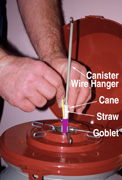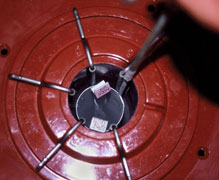Cryogenic storage containers for semen and embryos come in a number of designs. The most popular are liquid nitrogen storage tanks, vapor shippers, and even dual-purpose tanks that can provide both storage and a means for the shipping of semen. The tanks are essentially a large vacuum container with insulation inside the vacuum chamber, much like an oversized thermos. The working parts are a lid, styrofoam cork, canisters, the inner chamber that holds the liquid nitrogen, and a “spider” to keep the canisters from moving around. The cork is generally 4-6 inches in length with grooves down the sides for the canister hangers. The cork is designed to fit loosely in the neck of the tank, allowing for the evaporating nitrogen gas to escape. If capped too tightly, the gas would build pressure in the tank and cause it to eventually explode.
Hanging from the top/neck of the tank are the canisters, usually six in number, although tanks may contain as few as one or as many as ten. These canisters consist of a long wire hanger/handle used to bring the cylindrical portion of the canister in and out of the tank. The function of the canister is to hold the canes of semen or embryos down in the tank for storage and retrieval when necessary.

Cutout view of a liquid nitrogen semen storage tank showing insulation and cannisters

Parts of a semen storage tank

Inside view of a semen tank
Liquid nitrogen is at a temperature of -320 ° F (-196 ° C) and is a hazardous material. Great caution should be practiced when handling a liquid nitrogen tank and its contents. It is good to get in the habit of wearing safety glasses for eye protection and clothing covering exposed body extremities such as legs, feet, arms, and hands when working in your nitrogen tank. Gloves made of any cloth like material should not be worn as they can absorb and trap liquid nitrogen causing a severe burn to the hands and fingers. Rather, gloves should be made of rubber, latex, vinyl, nitrile, or some other tight-fitting, non-absorbent protective material.
Neck of semen tankCryogenic tanks come in a variety of configurations to meet the needs of the producer. Some have a long static hold and working time, generally sacrificing straw capacity; while others have large straw capacities, but sacrifice static hold and working time due to their increased neck size. This increased neck size is necessary to accommodate the larger canister size needed for the additional canes of inventory. A rule of thumb is the larger the neck opening, the easier it is to work in the tank, the more straws it can hold, and the faster the liquid nitrogen will evaporate thereby decreasing the static hold/working time between “charges” (liquid nitrogen refills) of the tank.
Things to take into consideration when purchasing a liquid nitrogen storage tank are straw capacity, initial price, liquid nitrogen availability in your area, static/hold time, and intended use of the tank. For example, a tank that holds 540 straws only has the capacity to hold 54 “canes” of inventory, with ten straws to the cane (an industry standard for 0.5 cc straws in the United States). Each cane holds two “goblets,” each goblet holds five 0.5 cc straws, totaling the ten straws per cane. If any of the canes has less than ten straws, capacity drops by the number of straws each cane is short of ten. For instance, if one cane is holding only two straws, eight straws of the tank’s total storage capacity is lost.
It also costs more to maintain four 540 straw capacity tanks than it does to maintain one 2,100 straw capacity tank. This is in addition to the higher initial cost involved in purchasing four smaller liquid nitrogen tanks as opposed to one larger tank. Good quality, new, liquid nitrogen storage tanks can vary in cost from about $650 to upwards of $1,000 depending on the make and model.
A person should check availability and cost of liquid nitrogen to assist in the decision of what model tank to purchase that best suits their use and maintenance budget.
A liquid nitrogen tank measuring stick should also be purchased. This is used to monitor the liquid nitrogen level in the tank on a regular basis to ensuring the tank’s continuous viability and the safe storage of its contents.
Liquid nitrogen tanks are somewhat fragile and care should be taken in their handling. Close attention should be paid to the vacuum port. Do not spill nitrogen on it or loss of vacuum may occur rendering the tank useless. Tanks should not be set unprotected on gravel, dirt, or concrete. They should be stored unboxed, in plain view, on surfaces such as clean carpet, wood, cardboard, a rubber mat, etc., to protect the bottom from dents and scratches.
It is essential for the producer to recognize the importance of proper product handling, storage, and cataloging of inventory whether it be semen or embryos. The top of each cane should be marked, clearly identifying the cane’s contents by the index code assigned to the donor animal by the processor. It is very poor practice to store more than one buck’s semen or doe’s embryos on a single cane. The producer should maintain a current catalog or “map” of the tank’s contents and identifying index codes at all times. Any change in inventory within the tank should be noted in the catalog or on the map. Searching for and locating semen by exposing individual straws of inventory to the air, while attempting to read them, is the poorest of practices and will render your inventory ineffective and severely compromised in short order.
When re-caning (dividing or combining canes of semen), a producer or technician should be in the habit of pouring liquid nitrogen into a small, dense Styrofoam box known as a “transfer box,” designed specifically for this purpose. The re-caning should be done in the box with straw tweezers while the goblets and the straws they contain are submersed in the liquid nitrogen. The most detrimental element to the long-term viability of straws frozen inside a storage tank is temperature change and fluctuation. If properly stored, frozen spermatozoa can be expected to remain viable for many, many years. In a perfect world, the frozen inventory would not leave the nitrogen until it is thawed for use. However, this is impractical for the producer’s purposes, so the goal is to move straws as quickly as possible, i.e., the “three second rule.”
When semen is being transferred or pulled for thawing and insemination use, the canister must be raised to facilitate the handling of the cane and eventual removal of the desired straw. Once removed above the neck of the tank, the cane and canister should be lowered back into the tank or placed in a transfer box within three seconds. This “three second rule” helps to avoid excessive temperature fluctuation within the straws that may compromise spermatozoa viability. Noise and boiling heard in the tank when canisters are raised and lowered indicates a temperature change has taken place; the more violent the boiling the greater the temperature change and the greater the likelihood of viability loss.
When attempting to locate a cane in a specific canister, the canister should remain at the bottom of the tank. To see into the canister simply position it centrally so that an AI light or flashlight shining through the tank’s neck will illuminate the tops of the canes. If properly positioned, there should be no need to raise the canister into the neck of the tank until you have identified the location of the cane where the desired straw is located. If the canister must be raised into the neck of the tank, remember the “three second rule.” After lowering the canister back into the tank because the three seconds have expired, allow it to remain in the nitrogen for 10-30 seconds, depending on the nitrogen level in the tank. When pulling straws for insemination, attention should be on the inventory going back into the tank, not the straw you intend to thaw. It is better to pull the canister up three times for three seconds, than one time for nine seconds.
Vapor/dry shippers
Vapor shippers are sometimes referred to as “dry shippers.” Their design provides safe transportation of frozen semen and embryos. Newer models are made of lightweight aluminum and most often have a single canister inside as opposed to the usual six in a “wet” storage model. These newer shipping units contain hydrophobic absorbent material which repels water but absorbs liquid nitrogen. Because of the absorbent nature of the material, should the unit tip during transit the liquid nitrogen will remain absorbed in the “sponge-like” material preventing any spillage. This unique design allows for an exempt status with normal carriers who would otherwise render the container hazardous in nature, further allowing a cost effective means of transport for the shipper and its frozen contents.
When semen or embryo inventory is received by way of a vapor shipper, it becomes the receiver’s responsibility to verify the contents. When making the transfer from the vapor shipper to the producer’s private inventory tank, it is a good idea to quickly glance (remembering the “three second rule”) at the goblet and confirm that what has been ordered has been delivered. It is the buyer’s responsibility to notify the supplier immediately if there is some discrepancy in the quantity or identification of the inventory received.
Lists of companies featuring caprine artificial insemination equipment, liquid nitrogen tanks, and supplies as well as companies that sell frozen buck semen are found at the end of this module.
Next
Module Home
Certification Table of Contents
Browsing Table of Contents
